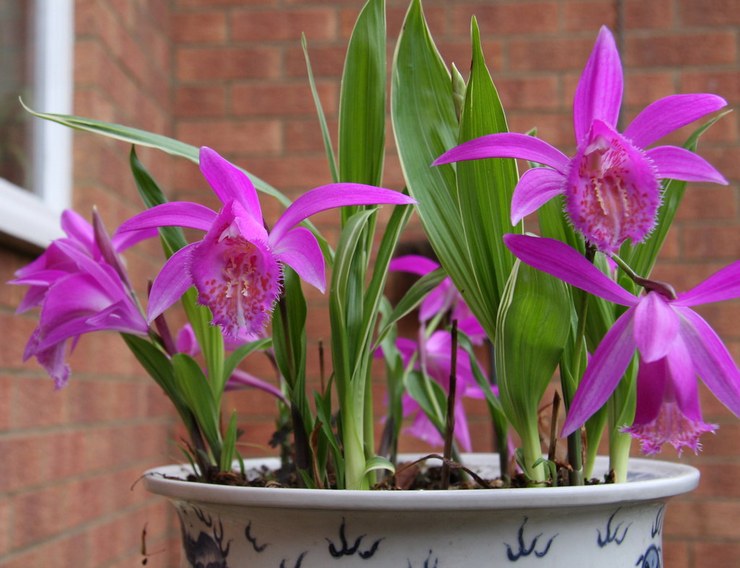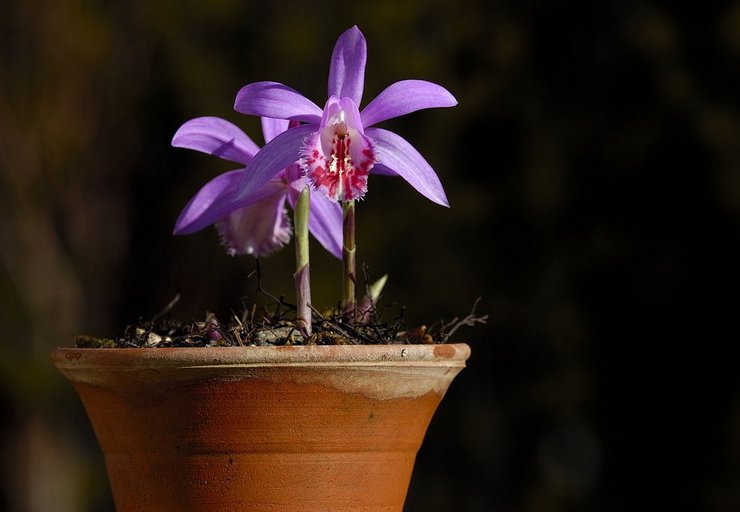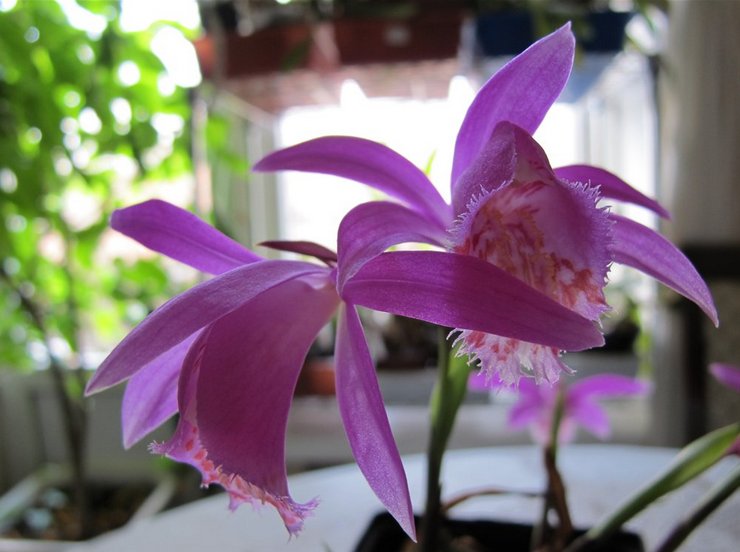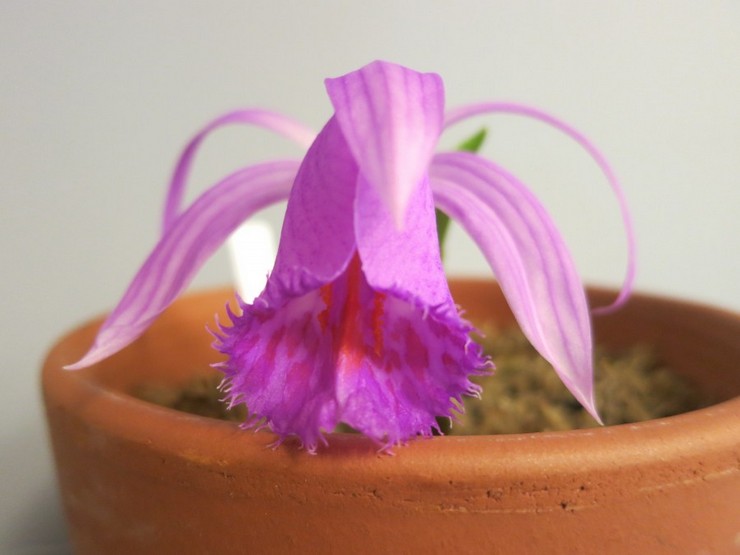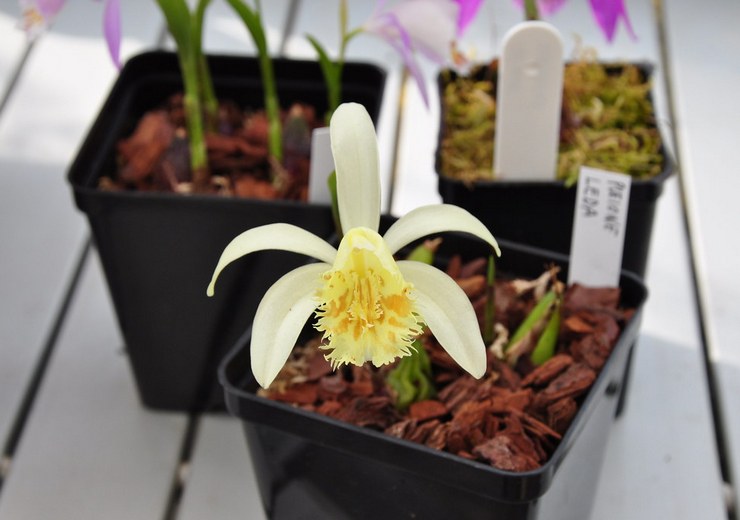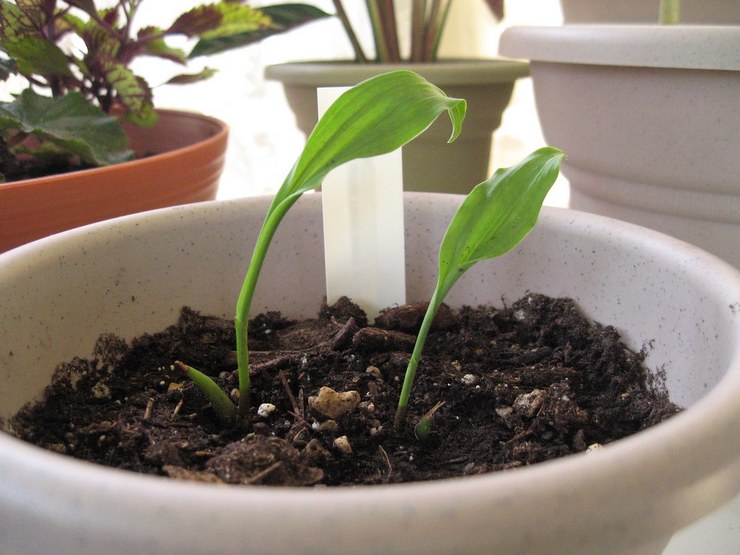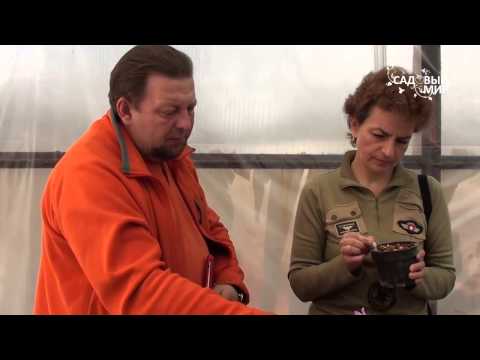The genus Pleione (Pleione) is a small representative of the orchid family, and includes about 20 wild and cultivated species. In the natural environment, this orchid occupies forest zones in Thailand, India, Laos and Burma, and also settles at the foot of the mountains of Nepal, Tibet and the Himalayas.
Description of orchids playone
Pleione grows according to the sympoidal type of branching and arrangement of shoots, i.e. develops horizontally, like a creeping vine. Bushes are undersized with round pseudobulbs of the size of a walnut. Air bulbs sit tightly next to each other. All year round, active life processes take place inside the bulbs. In spring, 1-2 leaves are formed on the narrowed top of the pseudobulb, the length of which reaches 10-20 cm as the bush matures. The leaves of the plant are attached to the petioles and have a lanceolate or ellipsoidal shape. On the leathery surface of the plates, in the center and in the lateral direction, there are thin veins.
In the autumn months, the leafy ground part of the orchid dies off. At the same time, inflorescences begin to appear on the shoots. Peduncles emerge from the base of the bulbs in early spring. The playone is characterized by single-flowered arrows with large cups up to 10 cm in diameter. The first row of petals grows together into a long, perpendicularly inclined tube with a dotted pattern. The tube is adorned with a fringed lip of a bright, noticeable color. The remaining petals in the amount of 5 pieces line up in the form of an asterisk with narrow, spread apart rays. The petals are lanceolate, spread out like a fan. From a distance, the peduncle resembles a peacock’s tail. Due to the original structure of the flower cup, the view looks unusual and differs from other orchid forms..
Through repeated research, breeders have bred about 150 Playone varieties of various sizes and colors that are suitable for home cultivation. There are plants with monochrome inflorescences and asteraceae species. Wild bushes are dominated by a delicate lilac-pink palette of buds, and pets are painted in snow-white, yellow, coral and pink shades. For example, the Tongariro cultivar has a purple corolla and a white tube with dark contrasting spots. Shantung has bright yellow flowers. A large patch with uneven outlines is visible on the sides of the lip. Snowcap orchid boasts white buds.
Home care for the playone orchid
With proper home care, the playone orchid is able to successfully adapt and develop. The flower grows well in the fresh air, therefore it is often used for garden cultivation..
Location and lighting
The pot is placed under diffused intense light, but protected from direct rays. Light partial shade in the hours of the sun will only benefit the plant. The orchid is placed on windowsills near windows facing east or west. Here foliage and buds will receive the necessary light recharge, and the flower will not experience discomfort from the heat and the hot sun..
Temperature
For full growth, the room temperature should be 18-22 ° C. Playone is not accustomed to the hot climate, therefore it is capricious if it lacks moisture.
Watering
The orchid is abundantly moisturized during the period of rapid growth of deciduous mass. The substrate needs constant moisture. For irrigation, only soft water is taken, which, as it follows, has settled at room temperature. Filtered water is ideal.
Air humidity
When the peduncles begin to protrude and leaves form, it is better to transfer the plant to a room with high humidity. The bushes refresh regularly. Without spraying, the plant withers and looks unattractive. Expanded clay is applied to the pallets and water is added to humidify the air.
Top dressing and fertilizers
It is enough to apply fertilizer once a week from the beginning of spring until the moment of attenuation of development and termination of vegetation. As a rule, for most varieties this happens in October. For the subcortex of the plant, a special fertilizer for orchid crops is used. In autumn, when the foliage turns yellow, the nutrition of the bushes is stopped.
The soil
Pleione is bred on a loose, airy substrate that can retain moisture. The soil should include pine bark, sphagnum and vermicompost. These natural ingredients are mixed in the same ratio.
Planting the bulbs is carried out in a low roomy pot with small holes, at the bottom of which crushed expanded clay or pebbles are poured, then the liquid can calmly seep through the soil, and the excess water evaporate.
Adult specimens are transplanted in the spring every year, trying to immerse the bulbs not too deep in the soil. The top is not covered with earth only for a quarter. Shrubs free from dried and old bulbs to make way for new material to form.
Dormant period
When the leaves of the playone fall off, and bare flower stalks remain in their place, the pot is rearranged to cool. The optimum temperature is 2 to 5 ° C. Lower temperature conditions will lead to freezing of the root system.
After the completion of physiological processes, resting pseudobulbs can be stored in several ways. For example, a container with a bush is moved to the basement. However, if the room is very cold, the bulbs will freeze. Another way is to get the bulbs, dry and cut the roots on the sides at a distance of 2-3 cm from the shell, and then wrap them in a plastic bag or newspaper. In this form, the material is kept on a shelf in the refrigerator in the section where fruits and vegetables are stored. It is important not to allow the bulbs to dry out and accumulate condensate in the wrapper, otherwise the material will not be suitable for planting..
Playground breeding methods
The playone orchid reproduces with the help of daughter bulbs, which are separated from the main plant after the establishment of spring warmth..
Diseases and pests
In the axils of the shoots, mealybugs and spider mites often hide. The leaves of the infected flower are washed under a warm shower. To prevent water from entering the pot, it is wrapped with polyethylene on top. If this method does not work, you will have to resort to treating the diseased culture with insecticide chemicals. The procedure is repeated if the pests could not be removed the first time. With improper care and transfusion of soil, the plant becomes sick with rot.
Orchids on the Pleione windowsill are snowdrop orchids. Site "Garden world"

